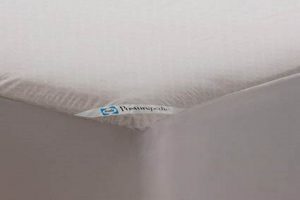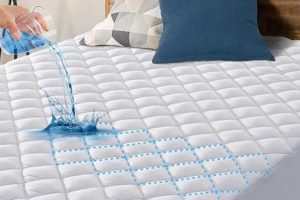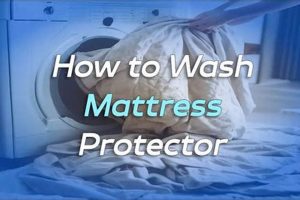A tightly woven fabric encasement designed to fully cover a mattress, preventing bed bugs from entering or escaping. These protective covers are typically waterproof and feature zippered closures that block even the smallest insects. This encasement acts as a physical barrier, preventing infestation and facilitating easier detection and eradication.
Employing such a barrier significantly reduces the risk of bed bug-related health issues such as skin irritation and allergic reactions. Furthermore, it preserves the lifespan and cleanliness of the mattress, negating the need for costly replacements due to infestation. The use of such protection has grown in parallel with increased awareness of bed bug infestations in recent decades, becoming a standard preventative measure in homes and hospitality settings.
The remainder of this discussion will detail the key features to consider when selecting a suitable mattress encasement, the different types available, and best practices for installation and maintenance to ensure long-term effectiveness.
Essential Considerations for Mattress Encasements
Selecting an effective mattress encasement requires careful evaluation of several key features to ensure comprehensive protection against bed bugs.
Tip 1: Material Composition: Opt for tightly woven fabrics with pore sizes small enough to prevent bed bug penetration. Polypropylene or polyester fabrics with a pore size of less than 6 micrometers are typically effective.
Tip 2: Zipper Quality: Ensure the encasement has a durable, high-quality zipper that extends around the entire mattress. Zippers should be tightly sealed with a fabric flap covering the closure to eliminate potential entry points.
Tip 3: Waterproofing: Consider a waterproof or water-resistant encasement. This feature not only protects against bed bugs but also safeguards the mattress from spills and stains.
Tip 4: Breathability: Look for encasements that offer some degree of breathability. This helps prevent moisture buildup within the mattress, reducing the risk of mold and mildew.
Tip 5: Independent Testing: Verify that the encasement has been independently tested and certified by a reputable laboratory to ensure its effectiveness in blocking bed bugs.
Tip 6: Proper Fit: Select an encasement that is appropriately sized for the mattress. A snug fit is essential to prevent gaps or loose areas where bed bugs could hide.
Tip 7: Maintenance and Care: Follow the manufacturer’s instructions for washing and drying the encasement to maintain its integrity and effectiveness. Regular inspection for tears or damage is also recommended.
By carefully considering these factors, individuals can select a mattress encasement that provides robust protection against bed bugs, prolonging the life of the mattress and ensuring a healthier sleep environment.
The following sections will address specific types of encasements and guidelines for installation.
1. Material Density
Material density is a primary determinant in the efficacy of a mattress encasement against bed bug infestations. The weave of the fabric acts as the first line of defense, preventing bed bugs from accessing the mattress fibers where they can harbor and reproduce.
- Pore Size and Bed Bug Immobility
Fabrics with extremely small pore sizes, ideally less than 6 micrometers, are essential. Bed bugs, even nymphs, cannot penetrate such tightly woven materials. Polypropylene and polyester fabrics, when manufactured with a high thread count and tight weave, effectively immobilize bed bugs, preventing them from establishing a colony within the mattress.
- Fabric Weave Integrity Under Stress
The integrity of the weave must withstand normal wear and tear. A loose weave or one that easily stretches allows gaps to form, negating the protective benefits. Material density must be maintained over time and under the weight of a sleeping person to consistently block bed bugs.
- Comparison of Materials: Natural vs. Synthetic
While natural fibers like cotton can be tightly woven, they often lack the durability and consistent pore size of synthetic options. Synthetic materials like polyester are less prone to shrinking or stretching, thus maintaining their barrier properties for a longer duration. Understanding these material properties is crucial for selecting an effective encasement.
- Impact on Encasement Breathability
Higher material density, while beneficial for pest control, can reduce breathability. The ideal encasement balances a tight weave with the ability to allow some air circulation, preventing moisture buildup and maintaining a comfortable sleeping surface. Microfiber fabrics often strike a good balance, providing a dense barrier with reasonable airflow.
In conclusion, material density directly affects the ability of a mattress encasement to serve as an effective barrier against bed bugs. The selection of materials with a high thread count, small pore size, and durable weave is paramount for providing long-term protection and preserving mattress integrity. The balance of density with breathability should also be considered to ensure a comfortable and sanitary sleep environment.
2. Zipper security
Zipper security represents a critical component of effective mattress encasements designed to protect against bed bug infestations. The zipper serves as the closure mechanism for the encasement, and any compromise in its integrity renders the entire protective barrier ineffective. An insecure zipper creates potential entry and exit points for bed bugs, allowing them to access the mattress core and establish colonies.
High-quality mattress encasements feature durable zippers that extend around the entire perimeter of the mattress, providing a complete seal. These zippers are often equipped with fabric flaps or Velcro closures that cover the zipper teeth, eliminating even the smallest gaps. The strength and durability of the zipper mechanism and the effectiveness of the closure are paramount. A weak zipper can separate under stress, while a poorly designed closure can leave minuscule openings that bed bugs can exploit. Regular inspection of the zipper’s integrity and proper closure is essential to maintain the encasement’s protective function. Practical applications include hotel management using high-quality zipped mattress protectors. These zipped mattress protectors helps from spreading mattress bug for good sanitary for their hotel guest.
In summary, the security of the zipper is inextricably linked to the overall effectiveness of a mattress encasement. Compromised zippers negate the protective benefits of the encasement, underscoring the importance of selecting encasements with robust zippers and implementing diligent inspection and maintenance practices. The challenge lies in ensuring both the zipper mechanism itself and its associated closure are impervious to bed bug penetration, thereby providing reliable protection against infestations.
3. Water resistance
Water resistance is a crucial feature of effective mattress encasements, complementing their primary function of preventing bed bug infestations. This characteristic enhances the protector’s utility by safeguarding the mattress from other common threats.
- Protection Against Liquid Damage
Water resistance shields the mattress from spills, sweat, and other fluids that can penetrate and damage the internal materials. This protection is vital for maintaining the mattress’s integrity and extending its lifespan. Without this safeguard, absorbed liquids can promote mold and mildew growth, creating an unsanitary environment.
- Facilitating Cleaning and Maintenance
Water-resistant surfaces enable easy cleaning of the encasement. Spills can be quickly wiped away, preventing stains and odors from developing. This simplified maintenance routine encourages regular cleaning, contributing to a more hygienic sleep environment. Encasements without this feature are more susceptible to permanent staining and require more intensive cleaning methods.
- Inhibition of Mold and Mildew Growth
By preventing liquids from soaking into the mattress, water resistance inhibits the growth of mold and mildew. These organisms thrive in moist environments, and their presence can trigger allergic reactions and respiratory issues. A dry mattress is less hospitable to these allergens, promoting a healthier sleep surface. This feature is critical in humid climates where mold growth is more prevalent.
- Maintaining Mattress Hygiene
Water resistance contributes to overall mattress hygiene by preventing the accumulation of bodily fluids and other contaminants. This feature is particularly important for individuals with allergies or sensitivities to dust mites, as a dry mattress is less likely to harbor these pests. A clean and dry mattress supports a more comfortable and restful sleep experience. Maintaining mattress hygiene has a direct effect for bed bug mattress protector to effectively eliminate bed bugs on the mattress.
In summary, water resistance significantly enhances the practicality and protective capabilities of mattress encasements. It not only safeguards the mattress from liquid damage and associated microbial growth but also simplifies cleaning and maintenance, promoting a more hygienic sleep environment and helping for bed bug mattress to eliminate bed bugs on mattress.
4. Breathability
Breathability is a crucial characteristic of an effective mattress encasement for bed bug protection. While the primary function of such a protector is to create an impenetrable barrier against bed bugs, a lack of breathability can lead to undesirable consequences, compromising comfort and potentially damaging the mattress itself. The ideal encasement balances protective function with the ability to allow airflow, preventing moisture accumulation within the mattress.
Insufficient breathability causes moisture buildup from perspiration and ambient humidity. This creates a conducive environment for mold and mildew growth within the mattress, negating the hygienic benefits of the encasement. Furthermore, trapped moisture can degrade the mattress materials over time, reducing its lifespan and potentially voiding warranties. For example, a hotel using non-breathable encasements reported increased mold issues and subsequent mattress replacements. Fabrics like tightly woven polyester or polypropylene offer effective bed bug protection but often lack breathability. Manufacturers address this by incorporating micro-pores or laminating the protective layer to a more breathable material. Some modern encasements utilize advanced membrane technologies that allow air and water vapor to pass through while remaining impermeable to liquids and bed bugs. Breathability directly affects the user experience and the long-term maintenance of both the encasement and the mattress.
Achieving optimal breathability in bed bug mattress protectors remains a significant design challenge. Manufacturers must balance the need for an impenetrable barrier with the equally important need for moisture control. Understanding the interplay between material science and practical user needs is essential in producing encasements that are both effective and comfortable. The selection of a breathable mattress encasement requires careful consideration of material properties, construction techniques, and potential trade-offs between protection and comfort, thus ensuring the longevity and hygienic integrity of the mattress.
5. Certifications
Third-party certifications are a critical indicator of a mattress encasement’s effectiveness in preventing bed bug infestations. These certifications provide independent verification of a product’s ability to meet specific standards, offering consumers a level of assurance beyond manufacturer claims. Independent laboratory testing ensures the encasement’s fabric pore size, zipper security, and overall construction prevent bed bug penetration and escape. The absence of recognized certifications raises questions regarding the encasement’s actual performance. Examples of reputable certifications include designations from entomological testing facilities that specialize in pest control products. These facilities subject encasements to rigorous testing protocols, simulating real-world infestation scenarios. Products that pass these tests receive certification, signaling that they provide a reliable barrier against bed bugs. Without such certifications, the consumer relies solely on marketing claims, increasing the risk of purchasing an ineffective product.
The practical significance of certifications extends beyond individual purchases. In the hospitality industry, where bed bug infestations can have severe financial and reputational consequences, certified mattress encasements are often a standard requirement. Hotels and lodging facilities prioritize certified products to mitigate the risk of infestations and protect their guests. Regulatory bodies and public health organizations also recognize the importance of certifications in promoting effective bed bug control strategies. The presence of certifications helps ensure that products used in residential and commercial settings meet minimum performance standards, reducing the likelihood of widespread infestations. Selecting a certified mattress encasement is a tangible step toward preventing and controlling bed bug infestations.
While certifications provide valuable assurance, consumers must also understand the limitations of these designations. Certifications typically focus on the encasement’s ability to prevent bed bug passage but may not address other factors, such as breathability or water resistance. It is essential to consider these additional factors in conjunction with certification status when choosing an encasement. Furthermore, vigilance is required to ensure certifications remain valid and are not misused or misrepresented. Despite these challenges, third-party certifications remain a key tool for identifying and selecting mattress encasements that offer reliable protection against bed bugs, thereby contributing to a healthier and more pest-free sleep environment.
6. Proper fit
Optimal performance of a mattress encasement relies critically on achieving a precise fit. Without appropriate sizing and secure enclosure, even the highest quality materials and construction techniques become ineffective, compromising its protective capabilities.
- Elimination of Gaps and Entry Points
A snug fit prevents gaps or loose areas where bed bugs could harbor and gain access to the mattress. Oversized encasements can leave folds and crevices that create harborage sites, while undersized encasements may strain seams and zippers, leading to failure. Correct sizing ensures a smooth, taut surface, eliminating these potential entry points.
- Maintaining Fabric Integrity
Proper fit minimizes stress on the encasement’s fabric and seams. Overstretching can compromise the weave and reduce its effectiveness as a barrier. A correctly sized encasement allows the fabric to function as intended, maintaining its pore size and preventing bed bug penetration. Ensuring the proper size allows for breathability for the bed bug mattress protector, helping it to become the best bed bug mattress protector on the market.
- Ensuring Zipper Functionality
A tight fit can strain the zipper, increasing the risk of separation or breakage. Conversely, a loose fit may prevent the zipper from fully closing, leaving gaps for bed bug entry. A correctly sized encasement allows the zipper to function smoothly and securely, providing a complete and reliable seal.
- Extending Encasement Lifespan
Proper fit reduces wear and tear on the encasement, prolonging its useful life. Overstretched or strained encasements are more likely to develop tears or seam failures, requiring premature replacement. Selecting the correct size maximizes the encasement’s durability and ensures long-term protection.
In summary, proper fit is not merely a matter of convenience but a fundamental requirement for ensuring the effectiveness and longevity of a mattress encasement. Selecting the appropriate size is essential for eliminating harborage sites, maintaining fabric integrity, ensuring zipper functionality, and maximizing the encasement’s lifespan, ultimately contributing to the establishment of a sanitary sleeping environment. A better fit means a better functioning bed bug mattress protector.
Frequently Asked Questions
This section addresses common inquiries regarding mattress encasements designed to protect against bed bug infestations, providing factual and objective information to guide informed decisions.
Question 1: How does a bed bug mattress protector effectively prevent infestations?
A tightly woven fabric encasement with a secure zipper creates an impenetrable barrier, preventing bed bugs from entering or escaping the mattress. This eliminates harborage sites and facilitates easier detection and eradication.
Question 2: What materials constitute the most effective mattress protectors?
Synthetic fabrics with a pore size of less than 6 micrometers, such as polypropylene or polyester, are generally regarded as most effective due to their tight weave and resistance to stretching or tearing.
Question 3: Is breathability a necessary feature in a mattress protector?
Yes, breathability is important. An impermeable encasement can trap moisture, leading to mold and mildew growth. Breathable materials help maintain a dry and sanitary sleep environment.
Question 4: How often should a bed bug mattress protector be cleaned?
The encasement should be cleaned according to the manufacturer’s instructions, typically every few months. Regular inspection for tears or damage is also recommended.
Question 5: What certifications are relevant when selecting a mattress protector?
Certifications from independent entomological testing facilities confirm the encasement’s ability to prevent bed bug passage. These certifications offer assurance of the product’s effectiveness.
Question 6: Can a mattress protector eliminate an existing bed bug infestation?
While a mattress protector prevents new infestations and contains existing ones, it will not eliminate bed bugs already present in the mattress. Complementary pest control measures are required for eradication.
The selection of a suitable mattress encasement involves careful consideration of material, construction, and certification, ensuring robust protection against bed bug infestations.
The following section will discuss installation best practices.
Selecting a Superior Bed Bug Mattress Protector
This discussion has comprehensively explored the critical factors in selecting an effective mattress encasement for bed bug prevention. Material density, zipper security, water resistance, breathability, certifications, and proper fit are all vital considerations. A superior protector combines these elements to create an impenetrable barrier, ensuring a secure and sanitary sleep environment.
Investing in a high-quality encasement represents a proactive measure against bed bug infestations, safeguarding both health and property. Ongoing vigilance and regular maintenance are essential for sustained effectiveness. Prioritizing these factors will contribute significantly to creating a bed bug-free sleeping space.





![Best Plastic Twin Mattress Protector [Guide] Now! Organic & Natural Mattress Buyer’s Guide: Non-Toxic Sleep Solutions Best Plastic Twin Mattress Protector [Guide] Now! | Organic & Natural Mattress Buyer’s Guide: Non-Toxic Sleep Solutions](https://mattressworldpa.com/wp-content/uploads/2025/07/th-2519-300x200.jpg)
![Is a Mattress Protector Worth It? [Need + Guide] Organic & Natural Mattress Buyer’s Guide: Non-Toxic Sleep Solutions Is a Mattress Protector Worth It? [Need + Guide] | Organic & Natural Mattress Buyer’s Guide: Non-Toxic Sleep Solutions](https://mattressworldpa.com/wp-content/uploads/2025/07/th-2518-300x200.jpg)
![Best Deep Mattress Protector [Guide] - Sleep Soundly! Organic & Natural Mattress Buyer’s Guide: Non-Toxic Sleep Solutions Best Deep Mattress Protector [Guide] - Sleep Soundly! | Organic & Natural Mattress Buyer’s Guide: Non-Toxic Sleep Solutions](https://mattressworldpa.com/wp-content/uploads/2025/07/th-2517-300x200.jpg)